tow KIA CEED 2016 Owner's Manual
[x] Cancel search | Manufacturer: KIA, Model Year: 2016, Model line: CEED, Model: KIA CEED 2016Pages: 643, PDF Size: 38.19 MB
Page 261 of 643
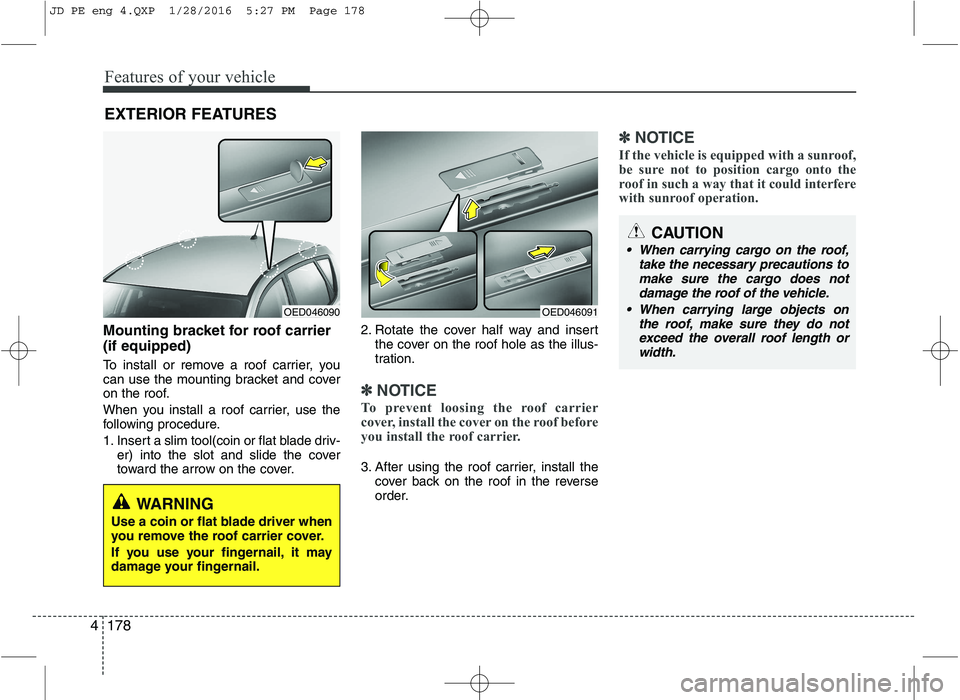
Features of your vehicle
178
4
Mounting bracket for roof carrier (if equipped)
To install or remove a roof carrier, you
can use the mounting bracket and cover
on the roof.
When you install a roof carrier, use the
following procedure.
1. Insert a slim tool(coin or flat blade driv-
er) into the slot and slide the cover
toward the arrow on the cover. 2. Rotate the cover half way and insert
the cover on the roof hole as the illus-
tration.
✽✽ NOTICE
To prevent loosing the roof carrier
cover, install the cover on the roof before
you install the roof carrier.
3. After using the roof carrier, install the cover back on the roof in the reverse
order.
✽✽ NOTICE
If the vehicle is equipped with a sunroof,
be sure not to position cargo onto the
roof in such a way that it could interfere
with sunroof operation.
EXTERIOR FEATURES
OED046090OED046091
WARNING
Use a coin or flat blade driver when
you remove the roof carrier cover.
If you use your fingernail, it may
damage your fingernail.
CAUTION
When carrying cargo on the roof, take the necessary precautions tomake sure the cargo does not damage the roof of the vehicle.
When carrying large objects on the roof, make sure they do notexceed the overall roof length or width.
JD PE eng 4.QXP 1/28/2016 5:27 PM Page 178
Page 266 of 643

Features of your vehicle
4183
AUX, USB and iPod
®
port
You can use an aux port to connect
audio devices and an USB port to
plug in an USB and also an iPod ®
port to plug in an iPod ®
.
✽✽ NOTICE
When using a portable audio device
connected to the power outlet, noise
may occur during playback. If this
happens, use the power source of the
portable audio device.
* iPod
®
is a trademark of Apple Inc. How Vehicle Audio Works
AM and FM radio signals are broad-
cast from transmitter towers located
around your city. They are intercept-
ed by the radio antenna on your vehi-
cle. This signal is then received by
the radio and sent to your vehicle
speakers.
When a strong radio signal has
reached your vehicle, the precise
engineering of your audio system
ensures the best possible quality
reproduction. However, in some
cases the signal coming to your vehi-
cle may not be strong and clear. This can be due to factors, such as
the distance from the radio station,
closeness of other strong radio sta-
tions or the presence of buildings,
bridges or other large obstructions inthe area.
JBM001
FM receptionOUM044044L
JD PE eng 4b (Audio).qxp 9/9/2015 5:09 PM Page 183
Page 375 of 643
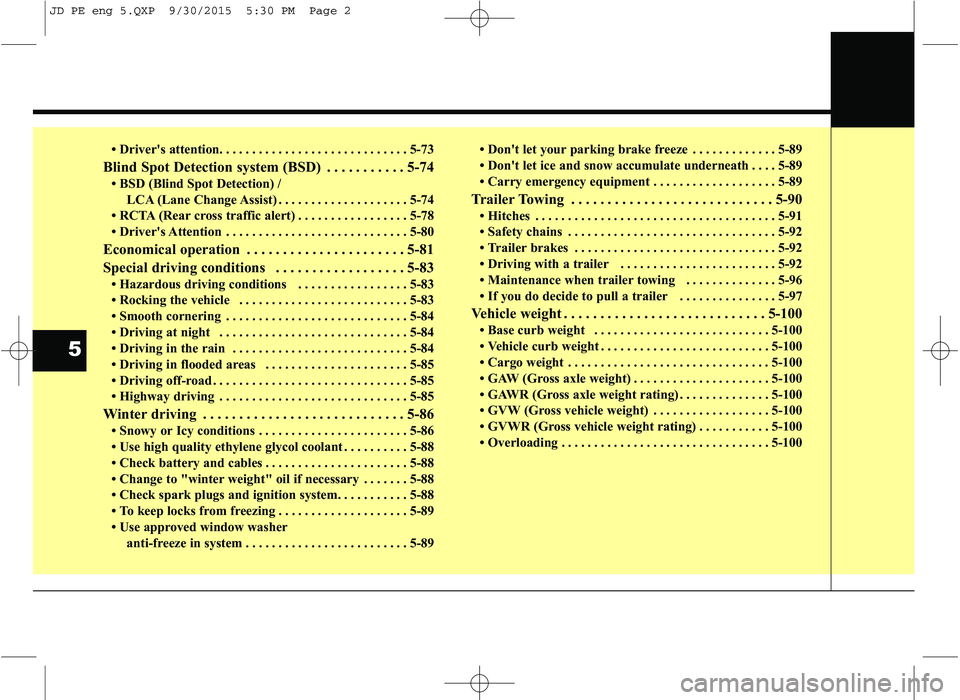
Driver's attention. . . . . . . . . . . . . . . . . . . . . . . . . . . . . 5-73
Blind Spot Detection system (BSD) . . . . . . . . . . . 5-74 BSD (Blind Spot Detection) / LCA (Lane Change Assist) . . . . . . . . . . . . . . . . . . . . 5-74
RCTA (Rear cross traffic alert) . . . . . . . . . . . . . . . . . 5-78
Driver's Attention . . . . . . . . . . . . . . . . . . . . . . . . . . . . 5-80
Economical operation . . . . . . . . . . . . . . . . . . . . . . 5-81
Special driving conditions . . . . . . . . . . . . . . . . . . 5-83 Hazardous driving conditions . . . . . . . . . . . . . . . . . 5-83
Rocking the vehicle . . . . . . . . . . . . . . . . . . . . . . . . . . 5-83
Smooth cornering . . . . . . . . . . . . . . . . . . . . . . . . . . . . 5-84
Driving at night . . . . . . . . . . . . . . . . . . . . . . . . . . . . . 5-84
Driving in the rain . . . . . . . . . . . . . . . . . . . . . . . . . . . 5-84
Driving in flooded areas . . . . . . . . . . . . . . . . . . . . . . 5-85
Driving off-road . . . . . . . . . . . . . . . . . . . . . . . . . . . . . . 5-85
Highway driving . . . . . . . . . . . . . . . . . . . . . . . . . . . . . 5-85
Winter driving . . . . . . . . . . . . . . . . . . . . . . . . . . . . 5-86 Snowy or Icy conditions . . . . . . . . . . . . . . . . . . . . . . . 5-86
Use high quality ethylene glycol coolant . . . . . . . . . . 5-88
Check battery and cables . . . . . . . . . . . . . . . . . . . . . . 5-88
Change to "winter weight" oil if necessary . . . . . . . 5-88
Check spark plugs and ignition system. . . . . . . . . . . 5-88
To keep locks from freezing . . . . . . . . . . . . . . . . . . . . 5-89
Use approved window washer anti-freeze in system . . . . . . . . . . . . . . . . . . . . . . . . . 5-89 Don't let your parking brake freeze . . . . . . . . . . . . . 5-89
Don't let ice and snow accumulate underneath . . . . 5-89
Carry emergency equipment . . . . . . . . . . . . . . . . . . . 5-89
Trailer Towing . . . . . . . . . . . . . . . . . . . . . . . . . . . . 5-90 Hitches . . . . . . . . . . . . . . . . . . . . . . . . . . . . . . . . . . . . . 5-91
Safety chains . . . . . . . . . . . . . . . . . . . . . . . . . . . . . . . . 5-92
Trailer brakes . . . . . . . . . . . . . . . . . . . . . . . . . . . . . . . 5-92
Driving with a trailer . . . . . . . . . . . . . . . . . . . . . . . . 5-92
Maintenance when trailer towing . . . . . . . . . . . . . . 5-96
If you do decide to pull a trailer . . . . . . . . . . . . . . . 5-97
Vehicle weight . . . . . . . . . . . . . . . . . . . . . . . . . . . . 5-100 Base curb weight . . . . . . . . . . . . . . . . . . . . . . . . . . . 5-100
Vehicle curb weight . . . . . . . . . . . . . . . . . . . . . . . . . . 5-100
Cargo weight . . . . . . . . . . . . . . . . . . . . . . . . . . . . . . . 5-100
GAW (Gross axle weight) . . . . . . . . . . . . . . . . . . . . . 5-100
GAWR (Gross axle weight rating) . . . . . . . . . . . . . . 5-100
GVW (Gross vehicle weight) . . . . . . . . . . . . . . . . . . 5-100
GVWR (Gross vehicle weight rating) . . . . . . . . . . . 5-100
Overloading . . . . . . . . . . . . . . . . . . . . . . . . . . . . . . . . 5-100
5
JD PE eng 5.QXP 9/30/2015 5:30 PM Page 2
Page 379 of 643

Driving your vehicle
6
5
Ignition switch position
LOCK
The steering wheel locks to protect
against theft. The ignition key can be
removed only in the LOCK position.
When turning the ignition switch to the
LOCK position, push the key inward at
the ACC position and turn the key towardthe LOCK position.
ACC (Accessory)
The steering wheel is unlocked and elec-
trical accessories are operative.
✽✽
NOTICE
If difficulty is experienced turning the
ignition switch to the ACC position, turn
the key while turning the steering wheel
right and left to release the tension.
ON
The warning lights can be checked
before the engine is started. This is the
normal running position after the engine
is started.
Do not leave the ignition switch ON if the engine is not running to prevent batterydischarge.
START
Turn the ignition key to the START posi-
tion to start the engine. The engine will
crank until you release the key; then it
returns to the ON position. The brake
warning lamp can be checked in thisposition.
WARNING - Ignition key
Never turn the ignition switch to LOCK or ACC while the vehicle is
moving. This would result in loss of
directional control and braking func-
tion, which could cause an accident.
The anti-theft steering column lock (if equipped) is not a substitute for
the parking brake. Before leaving
the driver’s seat, always make sure
the shift lever is engaged in 1 st
gear
for the manual transaxle or P (Park)
for the automatic transaxle, set the
parking brake fully and shut the
engine off. Unexpected and sud-
den vehicle movement may occur ifthese precautions are not taken.
Never reach for the ignition switch, or any other controls through the
steering wheel while the vehicle is in
motion. The presence of your handor arm in this area could cause a
loss of vehicle control, an accident
and serious bodily injury or death.
Do not place any movable objects around the driver’s seat as they
may move while driving, interferewith the driver and lead to an acci-dent.
JD PE eng 5.QXP 9/30/2015 5:22 PM Page 6
Page 418 of 643
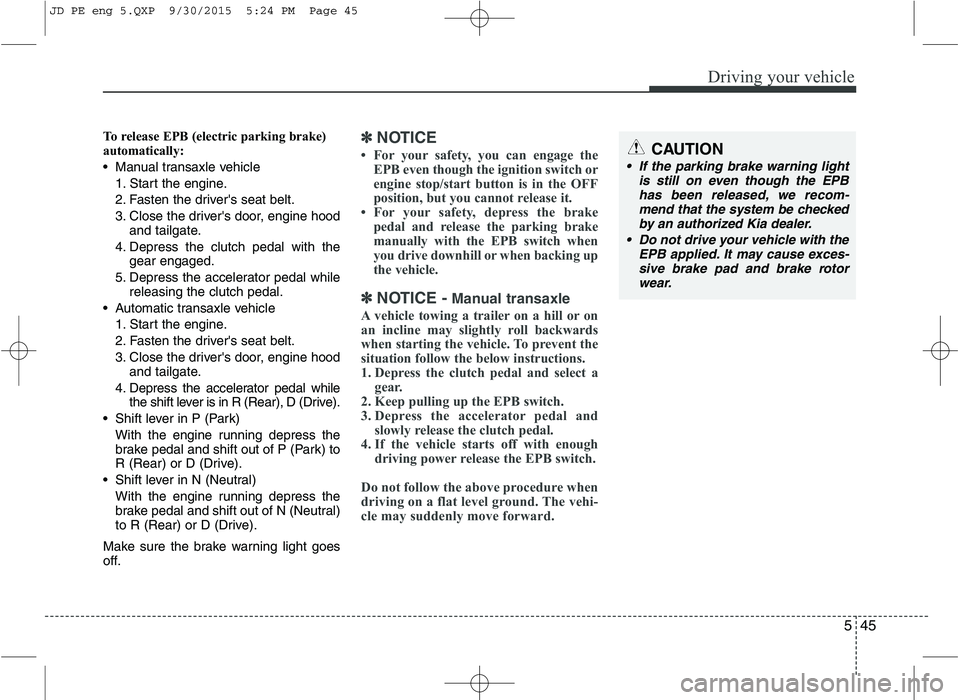
545
Driving your vehicle
To release EPB (electric parking brake)
automatically:
Manual transaxle vehicle1. Start the engine.
2. Fasten the driver's seat belt.
3. Close the driver's door, engine hood and tailgate.
4. Depress the clutch pedal with the gear engaged.
5. Depress the accelerator pedal while releasing the clutch pedal.
Automatic transaxle vehicle 1. Start the engine.
2. Fasten the driver's seat belt.
3. Close the driver's door, engine hood and tailgate.
4. Depress the accelerator pedal while the shift lever is in R (Rear), D (Drive).
Shift lever in P (Park) With the engine running depress thebrake pedal and shift out of P (Park) to
R (Rear) or D (Drive).
Shift lever in N (Neutral) With the engine running depress the
brake pedal and shift out of N (Neutral)
to R (Rear) or D (Drive).
Make sure the brake warning light goes
off.✽✽ NOTICE
For your safety, you can engage the EPB even though the ignition switch or
engine stop/start button is in the OFF
position, but you cannot release it.
For your safety, depress the brake
pedal and release the parking brake
manually with the EPB switch when
you drive downhill or when backing up
the vehicle.
✽
✽ NOTICE - Manual transaxle
A vehicle towing a trailer on a hill or on
an incline may slightly roll backwards
when starting the vehicle. To prevent the
situation follow the below instructions.
1. Depress the clutch pedal and select a gear.
2. Keep pulling up the EPB switch.
3. Depress the accelerator pedal and
slowly release the clutch pedal.
4. If the vehicle starts off with enough
driving power release the EPB switch.
Do not follow the above procedure when
driving on a flat level ground. The vehi-
cle may suddenly move forward.
CAUTION
If the parking brake warning light is still on even though the EPBhas been released, we recom-mend that the system be checked
by an authorized Kia dealer.
Do not drive your vehicle with the EPB applied. It may cause exces-sive brake pad and brake rotor wear.
JD PE eng 5.QXP 9/30/2015 5:24 PM Page 45
Page 421 of 643

Driving your vehicle
48
5
Emergency braking
If there is a problem with the brake pedal
while driving, emergency braking is pos-
sible by pulling up and holding the EPB
switch. Braking is possible only while you
are holding the EPB switch.
✽✽
NOTICE
During emergency braking by the EPB,
the parking brake warning light will
illuminate to indicate that the system is
operating.
When the EPB (electric parking brake) does not release
If the EPB does not release normally, we
recommend that you take your vehicle to
an authorized Kia dealer by loading the
vehicle on a flatbed tow truck and have
the system checked. Anti-lock brake system (ABS)
WARNING
Do not operate the parking brake
while the vehicle is moving except
in an emergency situation.
CAUTION
If you continuously notice a noise or burning smell when the EPB is usedfor emergency braking, we recom-mend that the system be checked
by an authorized Kia dealer.
WARNING
ABS (or ESC) will not prevent acci-
dents due to improper or danger-
ous driving maneuvers. Even
though vehicle control is improved
during emergency braking, always
maintain a safe distance between
you and objects ahead. Vehicle
speeds should always be reduced
during extreme road conditions.
The braking distance for vehicle
equipped with an anti-lock braking
system (or Electronic Stability
Control) may be longer than for
those without it in the following
road conditions.
During these conditions the vehicle should be driven at reducedspeeds:
Rough, gravel or snow-covered roads.
With tire chains installed.
On roads where the road surface is pitted or has different surface height.
(Continued)
JD PE eng 5.QXP 9/30/2015 5:25 PM Page 48
Page 443 of 643
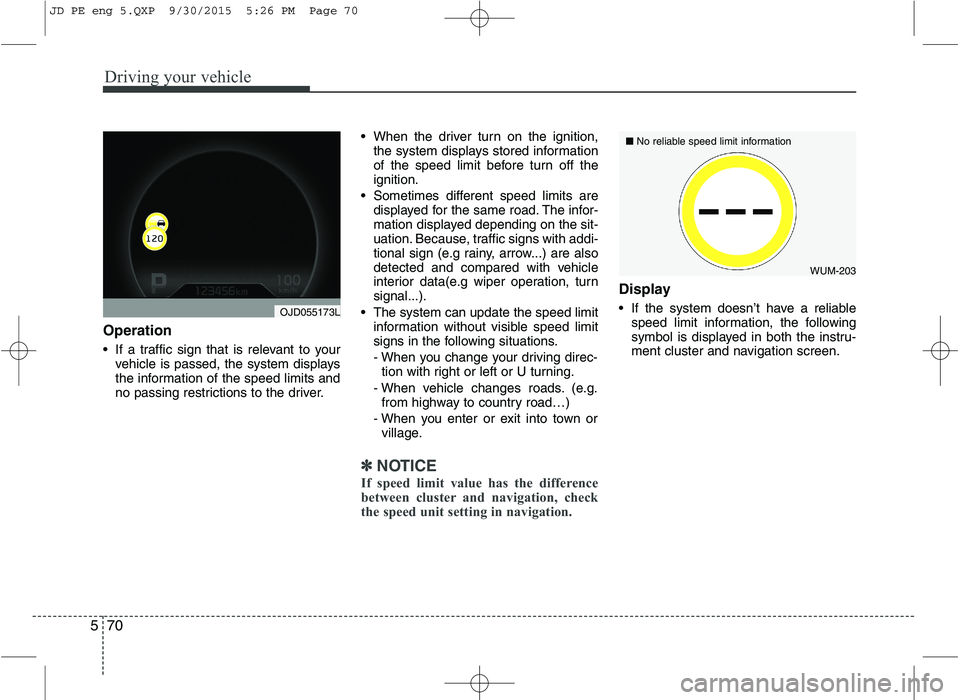
Driving your vehicle
70
5
Operation
If a traffic sign that is relevant to your
vehicle is passed, the system displays
the information of the speed limits and
no passing restrictions to the driver. When the driver turn on the ignition,
the system displays stored information
of the speed limit before turn off theignition.
Sometimes different speed limits are displayed for the same road. The infor-
mation displayed depending on the sit-
uation. Because, traffic signs with addi-
tional sign (e.g rainy, arrow...) are also
detected and compared with vehicle
interior data(e.g wiper operation, turnsignal...).
The system can update the speed limit information without visible speed limit
signs in the following situations.
- When you change your driving direc-
tion with right or left or U turning.
- When vehicle changes roads. (e.g. from highway to country road…)
- When you enter or exit into town or village.
✽✽ NOTICE
If speed limit value has the difference
between cluster and navigation, check
the speed unit setting in navigation.
Display
If the system doesn’t have a reliable speed limit information, the following
symbol is displayed in both the instru-
ment cluster and navigation screen.
WUM-203
■
No reliable speed limit information
OJD055173L
JD PE eng 5.QXP 9/30/2015 5:26 PM Page 70
Page 456 of 643
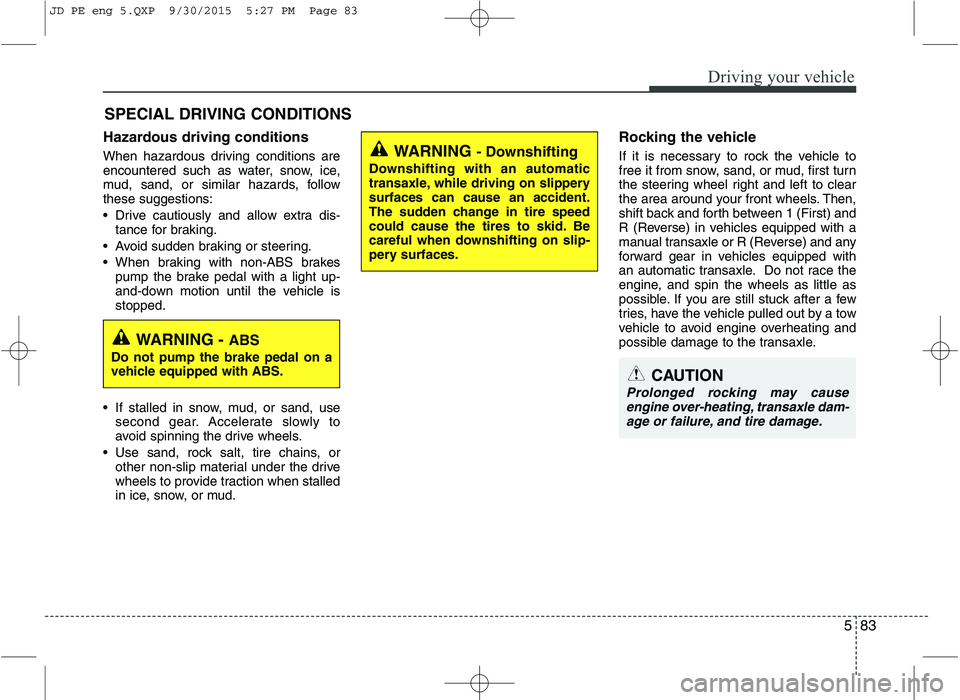
583
Driving your vehicle
Hazardous driving conditions
When hazardous driving conditions are
encountered such as water, snow, ice,
mud, sand, or similar hazards, followthese suggestions:
Drive cautiously and allow extra dis-tance for braking.
Avoid sudden braking or steering.
When braking with non-ABS brakes pump the brake pedal with a light up-
and-down motion until the vehicle isstopped.
If stalled in snow, mud, or sand, use second gear. Accelerate slowly to
avoid spinning the drive wheels.
Use sand, rock salt, tire chains, or other non-slip material under the drive
wheels to provide traction when stalled
in ice, snow, or mud. Rocking the vehicle
If it is necessary to rock the vehicle to
free it from snow, sand, or mud, first turn
the steering wheel right and left to clear
the area around your front wheels. Then,
shift back and forth between 1 (First) and
R (Reverse) in vehicles equipped with a
manual transaxle or R (Reverse) and any
forward gear in vehicles equipped with
an automatic transaxle. Do not race the
engine, and spin the wheels as little as
possible. If you are still stuck after a few
tries, have the vehicle pulled out by a tow
vehicle to avoid engine overheating and
possible damage to the transaxle.
SPECIAL DRIVING CONDITIONS
WARNING
- Downshifting
Downshifting with an automatic
transaxle, while driving on slipperysurfaces can cause an accident.
The sudden change in tire speed
could cause the tires to skid. Be
careful when downshifting on slip-
pery surfaces.
WARNING - ABS
Do not pump the brake pedal on a
vehicle equipped with ABS.
CAUTION
Prolonged rocking may cause engine over-heating, transaxle dam- age or failure, and tire damage.
JD PE eng 5.QXP 9/30/2015 5:27 PM Page 83
Page 462 of 643

589
Driving your vehicle
To keep locks from freezing
To keep the locks from freezing, squirt an
approved de-icer fluid or glycerine into
the key opening. If a lock is covered with
ice, squirt it with an approved de-icing
fluid to remove the ice. If the lock is
frozen internally, you may be able to thaw
it out by using a heated key. Handle the
heated key with care to avoid injury.
Use approved window washer
anti-freeze in system
To keep the water in the window washer
system from freezing, add an approved
window washer anti-freeze solution in
accordance with instructions on the con-
tainer. Window washer anti-freeze is
available from an authorized Kia dealer
and most auto parts outlets. Do not useengine coolant or other types of anti-
freeze as these may damage the paintfinish.Don't let your parking brake
freeze
Under some conditions your parking
brake can freeze in the engaged position.
This is most likely to happen when there
is an accumulation of snow or ice around
or near the rear brakes or if the brakes
are wet. If there is a risk the parking
brake may freeze, apply it only temporar-
ily while you put the shift lever in P (auto-
matic transaxle) or in first or reverse gear
(manual transaxle) and block the rear
wheels so the vehicle cannot roll. Then
release the parking brake.
Don't let ice and snow accumu- late underneath
Under some conditions, snow and ice
can build up under the fenders and inter-
fere with the steering. When driving in
severe winter conditions where this may
happen, you should periodically check
underneath the vehicle to be sure the
movement of the front wheels and the
steering components is not obstructed.Carry emergency equipment
Depending on the severity of the weath-
er, you should carry appropriate emer-
gency equipment. Some of the items you
may want to carry include tire chains, tow
straps or chains, flashlight, emergency
flares, sand, shovel, jumper cables, win-
dow scraper, gloves, ground cloth, cover-
alls, blanket, etc.
JD PE eng 5.QXP 9/30/2015 5:27 PM Page 89
Page 463 of 643
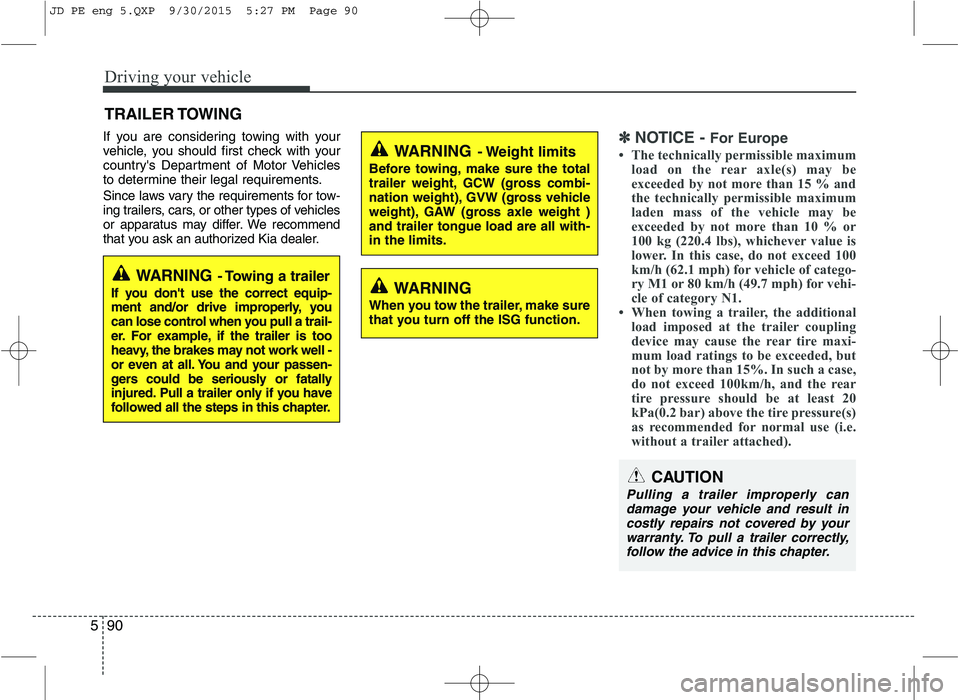
Driving your vehicle
90
5
If you are considering towing with your
vehicle, you should first check with your
country's Department of Motor Vehicles
to determine their legal requirements.
Since laws vary the requirements for tow-
ing trailers, cars, or other types of vehicles
or apparatus may differ. We recommend
that you ask an authorized Kia dealer.✽✽
NOTICE - For Europe
The technically permissible maximum load on the rear axle(s) may be
exceeded by not more than 15 % and
the technically permissible maximum
laden mass of the vehicle may be
exceeded by not more than 10 % or
100 kg (220.4 lbs), whichever value is
lower. In this case, do not exceed 100
km/h (62.1 mph) for vehicle of catego-
ry M1 or 80 km/h (49.7 mph) for vehi-
cle of category N1.
When towing a trailer, the additional
load imposed at the trailer coupling
device may cause the rear tire maxi-
mum load ratings to be exceeded, but
not by more than 15%. In such a case,
do not exceed 100km/h, and the rear
tire pressure should be at least 20
kPa(0.2 bar) above the tire pressure(s)
as recommended for normal use (i.e.
without a trailer attached).
TRAILER TOWING
CAUTION
Pulling a trailer improperly can
damage your vehicle and result in
costly repairs not covered by yourwarranty. To pull a trailer correctly, follow the advice in this chapter.
WARNING - Towing a trailer
If you don't use the correct equip-
ment and/or drive improperly, you
can lose control when you pull a trail-
er. For example, if the trailer is too
heavy, the brakes may not work well -
or even at all. You and your passen-
gers could be seriously or fatally
injured. Pull a trailer only if you have
followed all the steps in this chapter.
WARNING - Weight limits
Before towing, make sure the total
trailer weight, GCW (gross combi-
nation weight), GVW (gross vehicle
weight), GAW (gross axle weight )and trailer tongue load are all with-in the limits.
WARNING
When you tow the trailer, make sure
that you turn off the ISG function.
JD PE eng 5.QXP 9/30/2015 5:27 PM Page 90